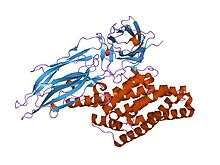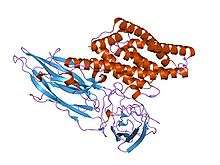Delta endotoxins (δ-endotoxins, also called Cry and Cyt toxins) are pore-forming toxins produced by Bacillus thuringiensis species of bacteria. They are useful for their insecticidal action and are the primary toxin produced by Bt corn.
During spore formation the bacteria produce crystals of this protein. When an insect ingests these proteins, they are activated by proteolytic cleavage. The N-terminus is cleaved in all of the proteins and a C-terminal extension is cleaved in some members. Once activated, the endotoxin binds to the gut epithelium and causes cell lysis by the formation of cation-selective channels, which leads to death. The activated region of the delta toxin is composed of three distinct structural domains: an N-terminal helical bundle domain (InterPro: IPR005639) involved in membrane insertion and pore formation; a beta-sheet central domain involved in receptor binding; and a C-terminal beta-sandwich domain (InterPro: IPR005638) that interacts with the N-terminal domain to form a channel.[2][3][4][5]
References
- ↑ Li JD, Carroll J, Ellar DJ (October 1991). "Crystal structure of insecticidal delta-endotoxin from Bacillus thuringiensis at 2.5 A resolution". Nature. 353 (6347): 815–21. doi:10.1038/353815a0. PMID 1658659.
- ↑ Cygler M, Borisova S, Grochulski P, Masson L, Pusztai-carey M, Schwartz JL, Brousseau R (1995). "Bacillus thuringiensis CryIA(a) insecticidal toxin: crystal structure and channel formation". J. Mol. Biol. 254 (3): 447–464. doi:10.1006/jmbi.1995.0630. PMID 7490762.
- ↑ Ghosh D, Pangborn W, Galitsky N, Cody V, Wojtczak A, Luft JR, English L (2001). "Structure of the insecticidal bacterial delta-endotoxinCry3Bb1 of Bacillus thuringiensis". Acta Crystallogr. D. 57 (8): 1101–1109. doi:10.1107/S0907444901008186. PMID 11468393.
- ↑ Grochulski P, Masson L, Borisova S, Pusztai-Carey M, Schwartz JL, Brousseau R, Cygler M (December 1995). "Bacillus thuringiensis CryIA(a) insecticidal toxin: crystal structure and channel formation". J. Mol. Biol. 254 (3): 447–64. doi:10.1006/jmbi.1995.0630. PMID 7490762.
- ↑ Galitsky N, Cody V, Wojtczak A, Ghosh D, Luft JR, Pangborn W, English L (August 2001). "Structure of the insecticidal bacterial delta-endotoxin Cry3Bb1 of Bacillus thuringiensis". Acta Crystallogr. D. 57 (Pt 8): 1101–9. doi:10.1107/S0907444901008186. PMID 11468393.



